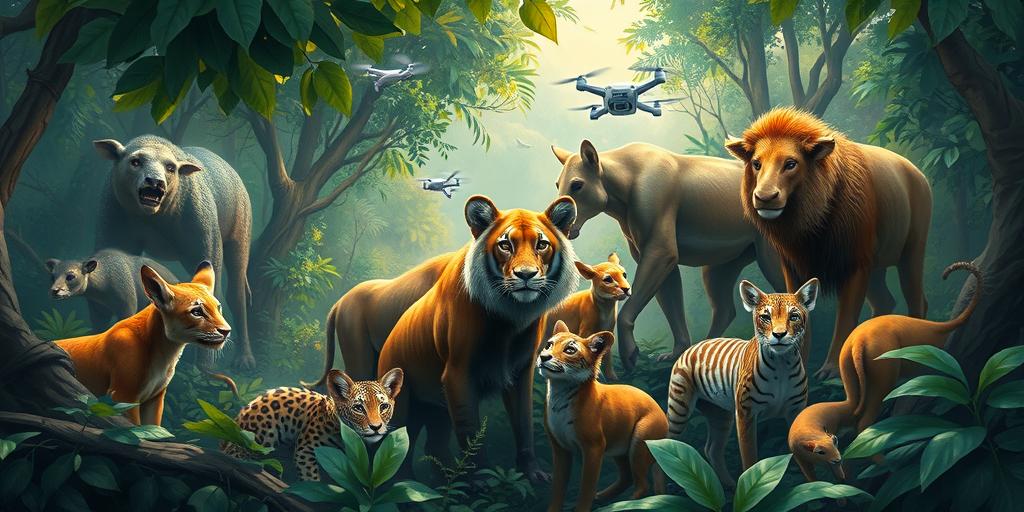Are you passionate about wildlife conservation? Do you want to know how groundbreaking technologies are revolutionizing the fight to protect endangered species? Prepare to be amazed! In this comprehensive exploration, we will unveil the incredible ways emerging technologies are reshaping wildlife conservation, offering a beacon of hope in the battle against extinction. From AI-powered anti-poaching measures to groundbreaking genetic research, the future of wildlife protection is now, and it’s more technologically advanced than you could ever imagine! Let’s dive into the fascinating world of technology-assisted conservation and discover how it’s helping endangered species thrive.
AI and Machine Learning: The Digital Guardians of Wildlife
Artificial intelligence (AI) and machine learning (ML) are rapidly transforming the landscape of conservation. These powerful technologies are being used to develop innovative solutions for protecting endangered species. AI-powered systems can analyze vast amounts of data from various sources, such as camera traps, satellite imagery, and acoustic sensors, to identify patterns and predict potential threats. This allows conservationists to proactively address challenges such as habitat loss, poaching, and human-wildlife conflict. Imagine a world where AI instantly detects illegal activities and alerts authorities before any harm is done to endangered species; this is the reality AI is creating.
Real-World Applications
Several organizations are already leveraging AI for conservation efforts. For example, the World Wildlife Fund (WWF) uses AI to analyze satellite imagery to identify areas of deforestation and poaching activity. This information helps them target their conservation efforts more effectively, leading to improved outcomes for endangered species. Moreover, machine learning algorithms are being trained to identify individual animals from their unique features, enabling researchers to track their movements and behavior over time. This granular level of data provides crucial insights into the factors affecting their survival and helps inform conservation strategies. This groundbreaking approach to conservation uses cutting-edge technology to help safeguard endangered species against poaching and habitat destruction.
Drones: A Bird’s-Eye View for Conservation
Unmanned aerial vehicles (UAVs), or drones, are becoming increasingly important tools in wildlife conservation. Their ability to access remote and difficult-to-reach areas makes them invaluable for monitoring endangered species and their habitats. Drones equipped with high-resolution cameras can capture detailed images and videos, providing critical data on animal populations, distribution, and behavior. This information can be used to assess the effectiveness of conservation interventions and to identify areas where additional support is needed. This non-invasive technology allows for detailed monitoring without disturbing the very species we are trying to protect, a fantastic development in the fight for biodiversity.
Monitoring Endangered Species
Drones can be used to track the movements of endangered animals, providing valuable insights into their behavior and habitat use. This information is crucial for understanding the threats they face and for developing effective conservation strategies. Imagine being able to monitor the daily migratory patterns of endangered birds, mapping their exact flight paths and identifying areas where they might be at risk. This level of precision is only possible thanks to the innovative application of drones in modern conservation efforts.
Genetic Technologies: A New Frontier in Conservation
Genetic technologies are rapidly advancing, opening up exciting possibilities for conservation efforts. Scientists are now using genetic analysis to identify endangered species, monitor genetic diversity, and track the movement of animals within and between populations. This information can be used to inform captive breeding programs, habitat restoration efforts, and other conservation interventions that boost the chance of endangered species survival. The possibilities here are truly remarkable, offering hope for the survival of species teetering on the brink of extinction.
Genetic Diversity and Conservation
Genetic technologies are being used to assess the genetic diversity of endangered species. Low genetic diversity can make a species more vulnerable to disease and environmental changes. By identifying populations with low genetic diversity, conservationists can take steps to increase their genetic variability, enhancing their resilience and long-term survival. This ensures genetic diversity, a critical aspect for preventing future population bottlenecks in endangered species.
The Power of Collaboration: Combining Technologies for Maximum Impact
The most effective conservation efforts often involve combining multiple technologies to achieve a synergistic effect. By integrating AI, drones, genetic analysis, and other cutting-edge technologies, conservationists can gain a comprehensive understanding of endangered species and their habitats. This integrated approach is far more effective than a single, isolated approach, enhancing the potential of wildlife conservation projects significantly. This holistic approach maximizes efficiency and impact, offering unprecedented opportunities for protecting endangered species.
Combining different technologies creates a powerful toolkit, allowing researchers to collect, analyze and act on data more efficiently. This coordinated approach empowers scientists to swiftly respond to evolving threats and safeguard the planet’s biodiversity. The effective deployment of multiple technologies simultaneously creates a formidable barrier against extinction.
The future of wildlife conservation is bright thanks to technological innovation and collaborative efforts. Embracing these technologies and employing them strategically is paramount in conserving our planet’s biodiversity for future generations. Let’s work together to protect our shared heritage and ensure that these magnificent creatures continue to grace our planet for years to come. Get involved today!




